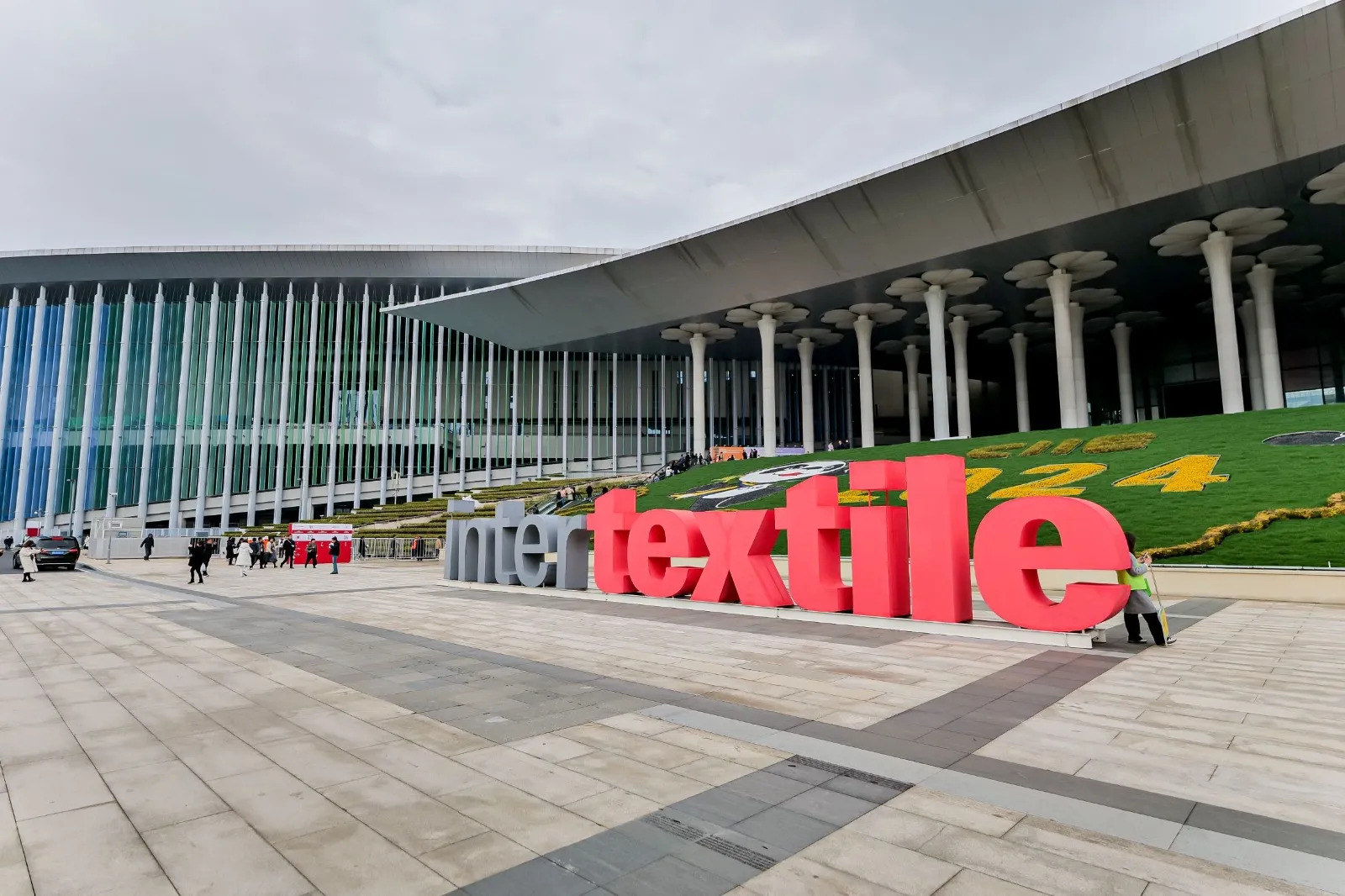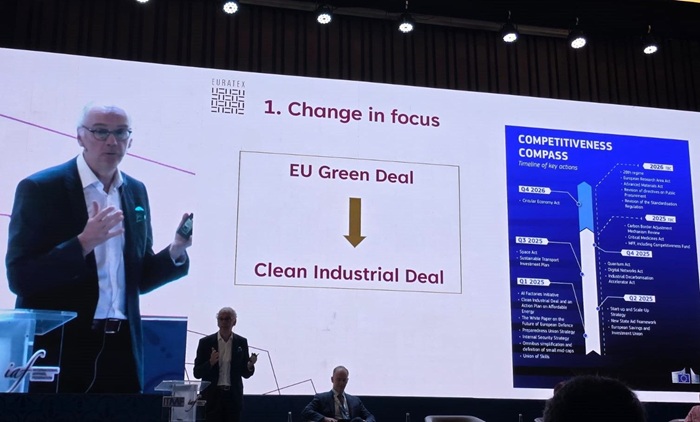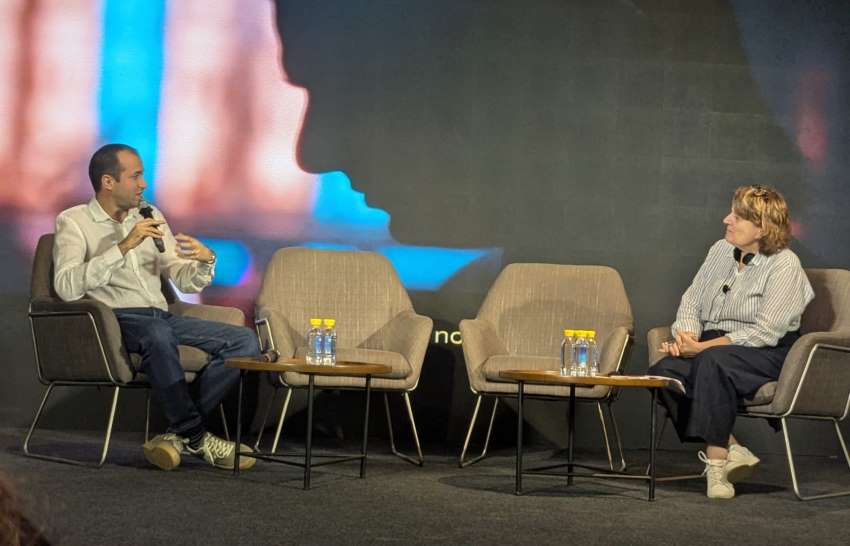FW
Confederation of Indian Textile Industry (CITI) projects, India’s T&A exports to the US will rise to $16 billion within the next three years if it pursues a ‘zero-for-zero’ trade agreement with the country. The proposed agreement would also help the industry eliminate all tariffs on textile and apparel products exchanged between the two nations.
Currently, India is the third-largest T&A supplier to the US market, trailing only China and Vietnam. From January to November 2024, the US accounted for 28.5 per cent of India's total textile and apparel exports.
In FY 2024, India exported $10.8 billion worth of goods to the US, while imports from the US amounted to a mere $0.41 billion.
While US textile imports from China have declined by 9.4 per cent CAGR over the past five years, imports from India have grown by 9.1 per cent CAGR, indicating a substantial opportunity for India to strengthen its presence in the US market.
However, recent trade tensions have prompted US companies to partially shift away from China, with the market shares of Vietnam and Bangladesh increasing by 7.8 per cent and 3 per cent, respectively. Both Vietnam and Bangladesh enjoy preferential trade agreements with the US for textiles, which include duty concessions.
To achieve this, India should pursue a zero-for-zero trade agreement with the US for textile and apparel products, incorporating necessary safeguards for sensitive items, states CITI. This agreement would provide a level playing field for Indian exporters, enabling them to compete effectively with Vietnam and Bangladesh, the trade body adds.
Furthermore, to ensure a balanced trade relationship given India's reliance on cotton imports from the US, CITI recommends a duty-free access mechanism with quota safeguards.
India’s rich fashion heritage, known for its handwoven textiles and intricate craftsmanship, is set to gain global momentum with the upcoming India-UK Free Trade Agreement (FTA). The deal aims to eliminate restrictive tariffs, creating new opportunities for designers, entrepreneurs, and artisans.
Sanjay Nigam, founder of the Fashion Entrepreneur Fund and the India Fashion Awards, views this as a pivotal moment for the industry. He highlights how trade barriers have long restricted Indian fashion’s competitiveness and believes the FTA will provide much-needed recognition and opportunity.
With negotiations in their 15th round, the agreement is expected to level the playing field for Indian brands, allowing them to compete without pricing disadvantages. While renowned designers like Sabyasachi Mukherjee and Gaurav Gupta have made a mark internationally, high tariffs have hindered broader industry growth.
India’s textile sector supports millions of artisans, weavers, and designers. The removal of trade barriers could drive investment, job creation, and supply chain expansion. The deal also aligns with the global shift toward sustainable and ethical fashion, an area where India has a natural advantage due to its eco-friendly textile traditions.
As the FTA moves closer to finalization, the Indian fashion industry is preparing for expansion. Emerging designers and heritage brands alike stand to benefit, making this agreement a potential breakthrough for India’s global fashion presence.
Intertextile Shanghai Apparel Fabrics - Spring Edition is set to take place from 11 to 13 March at the National Exhibition and Convention Center (Shanghai), bringing together over 3,100 exhibitors across seven halls. As one of the world’s leading textile trade fairs, the event will highlight fashion fabrics, accessories, functionality, sustainability, and digital transformation.
Wilmet Shea, General Manager of Messe Frankfurt (HK) Ltd, stated that the fair reflects market demands, covering four key industry segments on-trend fashion, functionality, sustainability, and digitalisation. She noted that visitors will have access to cutting-edge products and expert insights into design, technology, and eco-friendliness.
The fair’s fringe programme will feature key discussions on sustainability, technology, and fashion trends. The Econogy Talks will focus on circularity in the textile industry, supply chain legislation, and sustainability challenges. Speakers from Ecocert, Lenzing, Redress, and the Taiwan Textile Federation will share insights on how regulations are reshaping global supply chains. TextileGenesis will lead a seminar on supply chain traceability, and an Econogy Tour will showcase eco-focused exhibitors.
Another important panel discussion, ‘Shaping the Future of Sustainability Through Innovation,’ will include speakers from Eastman, High Fashion, HKRITA, and TextileGenesis, addressing ways to foster cooperation and drive impact in sustainability. The International Textile Industry Digital Application Forum will explore digital transformation in textiles.
Fashion trends will also be a key focus. Ornella Bignami of Elementi Moda will present the Intertextile Trend Forecast for Spring/Summer 2026, highlighting emerging colors, fabrics, and fashion directions. Laurie Pressman, Vice President of Pantone Color Institute, will discuss color influences in her session, "Mind: Blending the Balanced and Bold for a Mind-Bending Vision for Spring/Summer 2026." Bignami will also lead guided tours of the Intertextile Directions Trend Forum, offering visitors a deeper look into the international S/S 2026 I-dentities theme. Additionally, four domestic trend forums will showcase China’s evolving fashion landscape, covering denim, sustainable fashion, fashion focus, and functional textiles.
The exhibition will span 190,000 square meters, with exhibitors from 25 countries and regions. The International Hall (5.1) will feature key zones and pavilions, including France, Hong Kong, Italy, Japan, Korea, Taiwan, and Turkiye. Group pavilions will include Ecocert, Korea Textile Center (KTC), and Lenzing.
Domestic exhibitors will be organized by product categories, including ladieswear, suiting, shirting, functional wear, sportswear, casualwear, denim, lingerie, and children’s wear. The fair is co-organized by Messe Frankfurt (HK) Ltd, the Sub-Council of Textile Industry, CCPIT, and the China Textile Information Centre. It will run alongside Yarn Expo Spring, Intertextile Shanghai Home Textiles - Spring Edition, CHIC, and PH Value.
In collaboration with the London School of Trends (LST) and the High Commission of India in London, the New York Institute of Fashion (NIF Global) unveiled a stunning fashion showcase at London Fashion Week (LFW). Titled, ‘Indian Renaissance: Heritage Meets Sustainability,’ this year’s showcase celebrated India's rich textile heritage while pushing the boundaries of modern, eco-conscious design.
Building on the success of last year's ‘Roots to Runway,’ the 2025 showcase featured emerging designers from NIF Global's pan-India centers, blending traditional Indian craftsmanship with contemporary Western aesthetics. These young visionaries set a new standard for sustainable, global fashion, proving that heritage techniques and responsible fashion can coexist beautifully on the international stage.
The ‘Indian Renaissance’ collection celebrated a cross-cultural exchange, seamlessly weaving Indian handloom textiles, heritage embroidery, and age-old printing techniques into minimalist, Western-inspired silhouettes. Designed with sustainability at its core, the collection showcased eco-friendly materials such as organic cotton, khadi, handloom silk, and recycled fabrics, ensuring a reduced environmental footprint; a fusion of heavy, winter-friendly textiles with breathable weaves, making garments adaptable to global climates, traditional hand embroidery and surface ornamentation reimagined through contemporary construction and tailoring and avant-garde silhouettes, bringing together cultural depth and modern elegance.
The grand finale of the showcase featured an electrifying Bhangra performance by the Indian models on the runway, bringing the audience to their feet. The high-energy celebration perfectly captured the fusion of heritage and modernity, making for a spectacular wrap-up to the NIF Global x LST showcase.
Attended by global fashion leaders, influencers, and industry insiders, the event also highlighted the role of NIF Global x LST in mentoring the next generation of designers, equipping them with the tools to navigate the ever-evolving global fashion landscape. Through its strategic alliance with the London School of Trends (LST), NIF Global provides students with the right inspiration and motivation from style icon Ananya Panday.
Lotte Department Store plans to host a pop-up shop for the K-fashion brand ‘The Barnnet’ at the Lotte World Mall in Jamsil, marking the first time a domestic retailer has showcased the brand in South Korea.
The pop-up shop will be located on the first basement level of Lotte World Mall in Jamsil, Seoul, and will will offer an exclusive first look at The Barnnet’s new Spring/Summer (S/S) collection. More than 200 items, including bags, hats, and accessories, will be available in one convenient location.
Among the featured products are work jackets priced at 250,000 won, zip-up knitwear for 198,000 won, and ball caps for 42,000 won.
Founded in 2021, The Barnnet is a rising brand that has already made a name for itself internationally. The brand recently held a successful pop-up at Isetan Department Store in Shinjuku, Tokyo, where it generated 300 million won in sales in just one week. Recognized as a promising K-fashion brand with strong global appeal, The Barnnet has garnered significant attention in Japan.
The brand’s popularity is largely attributed to its unique design approach, which blends trendy classic styles with intricate details, resonating with young consumers in their 20s and 30s.
The pop-up shop’s interior is designed with a sophisticated, vintage-inspired aesthetic. The entrance features floral arrangements and arched spaces reminiscent of European antique boutiques. Soft pastel tones and premium fabrics create a warm and inviting atmosphere for shoppers.
To celebrate The Barnnet’s first pop-up in South Korea, customers will receive a photo booth pass with any purchase. On weekends, those who spend over 50,000 won in a single day will receive fresh flowers, available in limited quantities on a first-come, first-served basis. Additionally, customers who spend more than 400,000 won will be gifted an exclusive shoulder bag while supplies last.
Driven by heightened demand from the US and Europe, and a favorable currency depreciation, Bangladeshi T&A firms experienced a growth in revenue and profit during Q2, FY25 spanning October-December 2024. According to a ‘Textile Sector Update’ by CAL Securities, listed textile companies achieved a 20 per cent Y-o-Y revenue growth, reaching Tk44 billion during the quarter.
Revenues of apparel exporters grew by 43.1 per cent Y-o-Y Contributing nearly half of the sector's revenue, spinning mills reported a 23.5 per cent growth. Dyeing, fabric, and denim segments also experienced growth, while the home textile segment saw a slight decline.
The sector's net profit increased by 72 per cent Y-o-Y to Tk2.2 billion, with net profit margins improving to 5 per cent from 3.5 per cent. Lower cotton prices were a key factor in this profitability boost, despite the impact of elevated interest rates.
Bangladesh's ready-made garment (RMG) exports grew by 12 per cent in H1, FY25, despite political and labor disruptions. This recovery was fueled by increased demand from developed markets, supported by declining inflation and monetary easing.
Looking ahead, CAL Securities predicts, higher US tariffs on Chinese imports will shift more orders to emerging markets. However, Bangladesh needs to focus on value addition to remain competitive. While US apparel imports increased, Bangladesh's market share grew only slightly, indicating a need for diversification and high-value product expansion.
Segment-wise, Malek Spinning led the spinning sector with a 24 per cent revenue growth. Esquire Knit Composite dominated the apparel segment with an 80 per cent revenue increase and a profit turnaround. Envoy Textile led the denim segment with a 22 per cent revenue growth and a 158 per cent profit surge. Other notable performers included Square Textile, Matin Spinning, Queen South Textile, Monno Fabrics, Rahim Textile, Paramount Textile, Fareast Knitting, Shepherd Industries, and ML Dyeing. Conversely, ShaSha Denim, Evince Textile, and Hwa Well Textile underperformed. This robust performance signals a positive outlook for Bangladesh's textile industry, contingent on strategic adjustments to capitalize on global opportunities.
New York-based global designer, manufacturer, and distributor of apparel and accessories, United Legwear & Apparel Co (ULAC) has appointed Tony Lucia as the new President of its wholly owned subsidiaries, ULAC Europe BV and ULAC UK. Headquartered in the Netherlands and London, these subsidiaries oversee the company's European and UK operations.
Having an extensive experience in the industry, Lucia has previously served as the CEO and President (North, Central, and South America) for prominent fashion brands including Hugo Boss, Escada, and G-Star Raw. He also held key executive sales positions at Giorgio Armani/GFT, Donna Karan, and Andrew Fezza.
In his new position, Lucia will lead the expansion of key brands such as Scotch & Soda, Ted Baker (e-commerce), Hurley, and Skechers. He will work closely with ULAC's sales teams in the UK, Europe, and the US to strengthen retailer relationships, refine market strategies, and drive omnichannel sales growth. His expertise in operations, P&L management, supply chain optimization, and global e-commerce will be crucial to ULAC's growth.
Christopher J Volpe, COO/CFO, ULAC, says, Lucia’s deep industry knowledge and strategic vision are a perfect fit for ULAC's commitment to innovation and global growth. His proven leadership will help the company drive sustainable growth for brands across the UK, Europe, and beyond, he adds.
With Lucia's appointment, ULAC aims to expand its presence in Europe and the UK, increasing brand reach, and delivering high-quality apparel and accessories to a global customer base.
Leaders from the Indian textile and apparel (T&A) industry are urging the government to enter into ‘zero for zero’ tariff deal with the United States to protect strategic products from the reciprocal tariffs to be imposed by the US starting April 2, 2025.
Chandrima Chatterjee, Secretary General, Confederation of Indian Textile Industry (CITI) opines, US President's reciprocal tariff policy could help India strengthen export growth to the US.
Currently, India holds a mere 6 per cent share of the US apparel import market. Prabhu Damodaran, Convenor, Indian Texpreneurs Federation, emphasizes, even a 4 per cent increase would translate to a significant $3 billion opportunity.
India ranks as the third-largest supplier of T&A products to the US, behind China and Vietnam, with a 10.8 per cent market share of the $118.4 billion US import market. In 2024, US textile and apparel imports from India totaled $10.8 billion, while US exports to India were only $0.41 billion. India's imports primarily consist of fiber products, with cotton comprising 50.6%. K. Venkatachalam, Chief Advisor, Tamil Nadu Spinning Mills Association, stresses that current cotton shortages in India, due to crop failures, should be leveraged to gain trade advantages.
As the world's largest apparel importer, the US is a crucial export destination for India, accounting for 35 per cent of Indian apparel exports. Mithileshwar Thakur, Secretary General, AEPC, reports, in 2024, that apparel exports to the US increased by 11.2 per cent reached $5.2 billion
The T&A industry advocates for attention to manmade fibers, an emerging export sector. The AEPC identifies products with over $100 million in US exports and PLI scheme products as strategic for trade negotiations. In 2024, the US imported $79.26 billion in apparel, with China, Vietnam, Bangladesh, and India holding market shares of 21 per cent, 19 per cent, 9.3 per cent, and 5.9 per cent respectively.
The state government has approved eight additional proposals from entrepreneurs to establish mini textile parks in the Karur district, according to V Senthilbalaji, Electricity Minister.
Inaugurating a mini textile park in Kullampatti, alongside R Gandhi, Minister for Textiles and Handlooms, Senthilbalaji stated, a group of three entrepreneurs invested Rs 59 million ($710,000 approx.) in the project under the Tamil Nadu Mini Textile Park Scheme. Of the total expenditure, the state government will provide Rs 22 million ($265,000 approx.) in grants to the entrepreneurs. Of this amount, Rs 13.2 million ($160,000 approx.) has already been disbursed. The scheme is designed to share a portion of the costs associated with establishing these mini parks.
The state received ten more mini textile park proposals from Karur. Of those, eight have been approved, and the entrepreneurs have begun construction. Under the scheme, the state will cover 50 per cent of the expenses for establishing common facilities, infrastructure, and factory buildings. The maximum grant will be Rs 25 million ($300,000 approx.) for each park.
Later, Senthilbalaji and Gandhi inaugurated a common facility center in Velusamypuram, intended to benefit handloom weavers. A total of Rs 4.589 million ($55,000 approx.) was spent to establish the facility on a 2,430 sq ft site.
Even though handled by the Cotton Corporation of India (CCI), the Indian government's cotton procurement has reached 9.4 million bales, cotton prices continue to remain below the government-set Minimum Support Price (MSP) due to weak market demand. According to Lalit Kumar Gupta, Managing Director, says, procurement is going on across all states.
Data compiled by the Cotton Association of India (CAI), shows, cumulative market arrivals for the 2024-25 crop season totaled over 21.6 million bales (170 kg each) by March 1, 2025. CAI recently lowered its crop estimate to 30.175 million bales, while initial government estimates were 29.9 million bales.
The market for raw cotton and pressed bales is struggling due to weak demand, notes Pradeep Jain, President, Khandesh Ginners Association. Raw cotton prices are currently between ₹6,500 and Rs 7,000 per quintal, below the MSP level of Rs 7,121 (medium stable). Market arrivals of raw cotton have decreased because farmers, who have 10-15 per cent of their crop remaining, are choosing to hold onto their produce due to the low prices. However, the cottonseed market is showing some improvement, with prices rising Rs 200-300 per quintal to Rs 3,300-3,400, he adds.
Atul Ganatra, President, CAI, reports, daily arrivals have dropped below 90,000 bales, with CCI purchasing 40,000-50,000 bales. Ginners are barely receiving 40,000-45,000 bales, while mills need 100,000 bales daily. So, mills have started slightly increasing their purchases to build inventory at these current prices. However, mills are not buying at higher prices and are sticking to their own price points, he explains.
Furthermore, Ganatra states, mills prefer to maintain short-term inventories, buying only for one month at a time. Every mill wants to buy for one month to keep their operations running. They have confidence because CCI holds over 9 million bales, he adds.
While there's a perception that prices will stabilize once arrivals slow down, Ganatra believes Indian cotton prices won't rise unless ICE futures (the global cotton futures market) increase. Pressed cotton prices are currently hovering between Rs 53,000 and Rs 54,500 per candy, depending on quality.
Highlighting the unique challenges in the current market, Ramanuj Das Boob, a sourcing agent in Raichur, says, despite good crop yields from a slightly reduced planting area, prices remain stagnant between Rs 52,500 and Rs 54,000, creating market uncertainty. Cheaper imported cotton is further restraining domestic prices, with Indian mills having contracted approximately 2.9 million bales for import this year, he notes.












